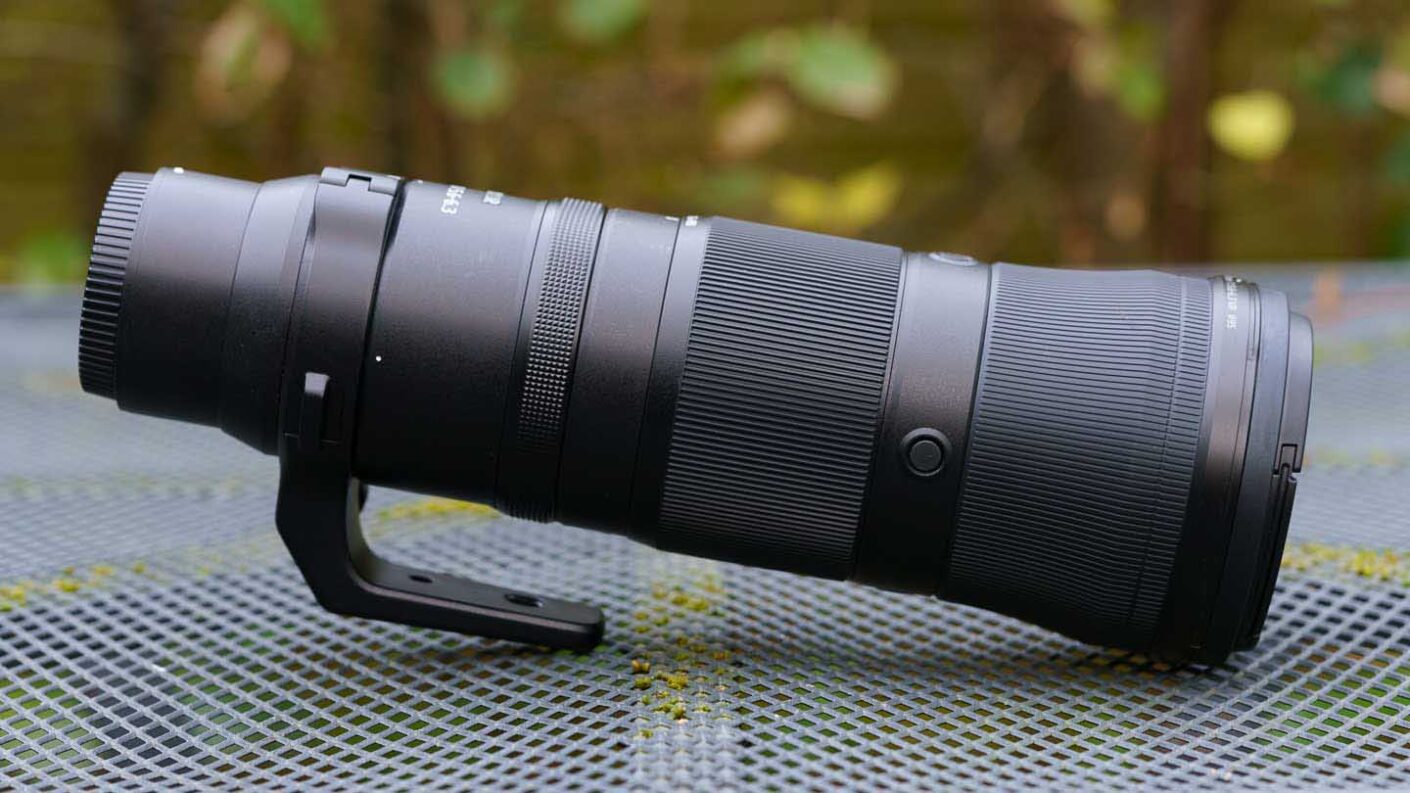The Nikon Nikkor Z 180-600mm f/5.6-6.3 VR is a super-telephoto zoom lens aimed at enthusiast photographers. Thanks to its long focal length range and compatibility with the Nikon’s Z-series teleconverters, the Z 180-600mm f/5.6-6.3 VR will appeal to keen sport, bird, wildlife and aviation photographers using Nikon’s Z-series mirrorless cameras.
Our Verdict
The Nikon Nikkor Z 180-600mm f/5.6-6.3 VR is an adaptable super-telephoto zoom lens, perfect for sports, wildlife and aviation photography enthusiasts. It’s compatible with Nikon’s Z-series teleconverters is an excellent bonus.
Despite its size and weight, the Z 180-600mm f/5.6-6.3 VR is practical for handheld shooting and well-suited for outdoor use due to its robust build and weather-sealing. The lens delivers sharp, high-quality images, including Nikon’s Vibration Reduction for steady shots. It performs impressively, providing excellent sharpness and controlled aberrations, though the narrow aperture may necessitate higher ISOs in low light.
Overall, it’s a well-considered, high-quality lens and a significant addition to Nikon’s mirrorless lineup.
For
- Internal zoom and focus mechanisms
- 5.5-stop stabilisation built-in
- Compatible with teleconverters
Against
- Inevitably big and heavy
- F/6.3 at the longest end
- Tripod foot collar is tricky to secure
What is the Nikon Nikkor Z 180-600mm f/5.6-6.3 VR?
Specification
- Product type: Super telephoto zoom lens
- Announced: 21st June 2023
- Mount: Nikon Z
- Format: Full-frame (FX)
- Focal length: 180-600mmmm
- Maximum aperture: f/5.6-6.3
- Minimum aperture: f/32-36
- Construction: 25 elements in 17 groups with 6 ED (Extra-low Dispersion) elements and 1 aspherical element elements
- Coatings: Fluorine-coated front lens element
- Focusing system: Internal with stepping motor (STM)
- Minimum focus distance: At 180mm: 1.3 m (4.27 ft), 200mm: 1.36 m (4.47 ft), 300mm: 1.67 m (5.48 ft), 400mm: 1.94 m (6.37 ft), 500mm: 2.19 m (7.19 ft), 600mm: 2.4 m (7.88 ft)
- Maximum reproduction ratio: 0.25x
- Stabilisation: Yes, 5.5EV compensation
- Number of diaphragm blades: 9
- Filter size: 95mm
- Weight: Without tripod collar: 1995g / 4 lbs 5 oz, With tripod collar: 2140g / 4 lbs 11.5 oz
- Diameter x length (extension from lens mount): 110 x 315.5mm / 4.4 x 12.5 inches
Nikon Nikkor Z 180-600mm f/5.6-6.3 VR Price and Availability
The Nikon Nikkor Z 180-600mm f/5.6-6.3 VR’s price is $1697 / £1799 / €2099, and it’s set to go on sale in Autumn 2023.

Features
While it is designed to cover a full-frame sensor, the Nikon Z 180-600mm f/5.6-6.3 VR can be mounted on the company’s APS-C format Z-series cameras such as the Nikon Z50 or Zfc, as well as its full-frame cameras such as the Nikon Z8 and Z7 II.
On an APS-C format camera, or on a full-frame camera in APS-C mode, the lens has an effective focal length of 270-900mm.
When combined with the Nikon Z Teleconverter TC-2.0x, the Z 180-600mm f/5.6-6.3 VR lens extends its capabilities significantly, offering a focal length range from 360mm to a staggering 1200mm. That could be especially useful for wildlife photography or shy and elusive subjects. Similarly, when used with the Nikon Z Teleconverter TC-1.4x, the lens achieves a focal length range of 270-840mm.
The Nikkor Z 180-600mm f/5.6-6.3 VR has a sophisticated optical construction with 25 elements arranged in 17 groups. This design includes 6 ED (Extra-low Dispersion) elements and 1 aspherical element, which contribute to its relatively compact size for the focal length range and ensure consistent image quality across the entire frame.
In addition, the front element is fluorine-coated to repel water droplets and fingerprints.
Nikon’s Vibration Reduction image stabilisation technology is also onboard, and is claimed to offer the ability to use shutter speeds up to 5.5EV slower than usual without the need for a tripod or monopod. That’s good news, but it’s worth keeping in mind that the lens will often be used to photograph moving subjects that require fairly fast shutter speeds.
Another attractive feature of the Nikon Z 180-600mm f/5.6-6.3 VR is its internal zoom and focusing functionality. This means that the lens maintains a consistent length throughout the focal length range and regardless of focusing adjustments. Consequently, it should be easier to keep the lens balanced and stable whether its being used handheld or mounted on a gimbal.
Focusing is handled by a linear stepping motor (STM), which is designed to be fast and quiet.
Although it’s not one of Nikon’s premium S-line lenses, the Nikkor Z 180-600mm f/5.6-6.3 VR has seals that make it resistant to dust and moisture. That’s helpful with a lens likely to be used in the wild.
Nikon supplies the Nikkor Z 180-600mm f/5.6-6.3 VR with a collar, foot and hood. It weighs 1955g without the collar ring and 2140g with it.
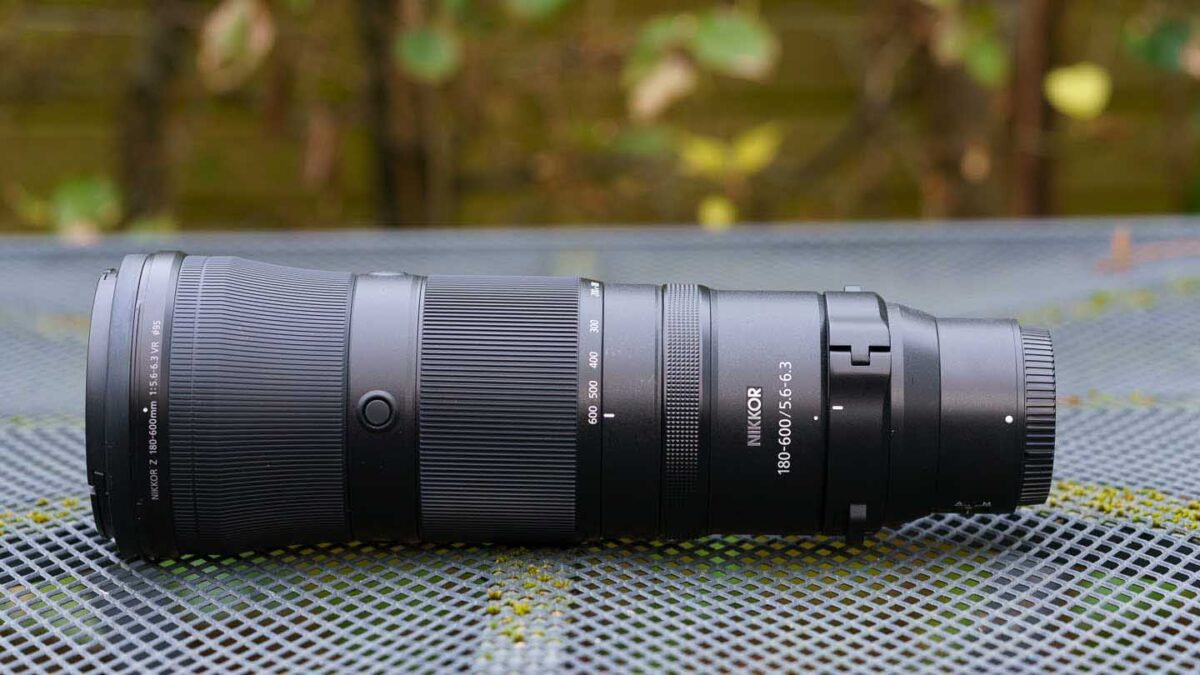
Build and handling
With a weight of 1995g (4 lbs 5 oz) without the tripod collar and 2140g (4 lbs 11.5 oz) with it, you can’t really call the Nikon Nikkor Z 180-600mm f/5.6-6.3 VR lightweight, but it’s not bad for it’s focal length range. It’s heavier than the Nikon Z 600mm f/6.3 VR S, which weighs 1470 g (3 lb 3.9 oz) with its tripod collar, for instance, but it brings the added flexibility of a zoom lens and is significantly more affordable at less than half the price.
It’s also a long lens, measuring 315.5mm (12.5 inches) and 110mm (4.4 inches) in diameter. For comparison, the Z 600mm f/6.3 VR S measures (D x L) 106.5 mm x 278 mm (4.2 x 11 inches). Nevertheless, I found the Z 180-600mm f/5.6-6.3 VR manageable. On a couple of occasions, I carried it for a full day of photography, shooting handheld. This was largely out of convenience because I was moving around a lot. If I was staying still for longer, I’d likely use it with a monopod such as the 3 Legged Thing Trent 2.0 or Taylor 2.0 with a tripod head or a gimbal (though they are heavy).
While it’s not a Nikon S-Line lens, the Nikkor Z 180-600mm f/5.6-6.3 VR feels well made and robust. It’s also weather-sealed, making it suitable for challenging outdoor conditions often faced by wildlife and sports photographers. However, I found the tripod collar tricky to seat properly after removing it and it’s easy to dislodge it when attempting to move it from the landscape to the portrait orientation.
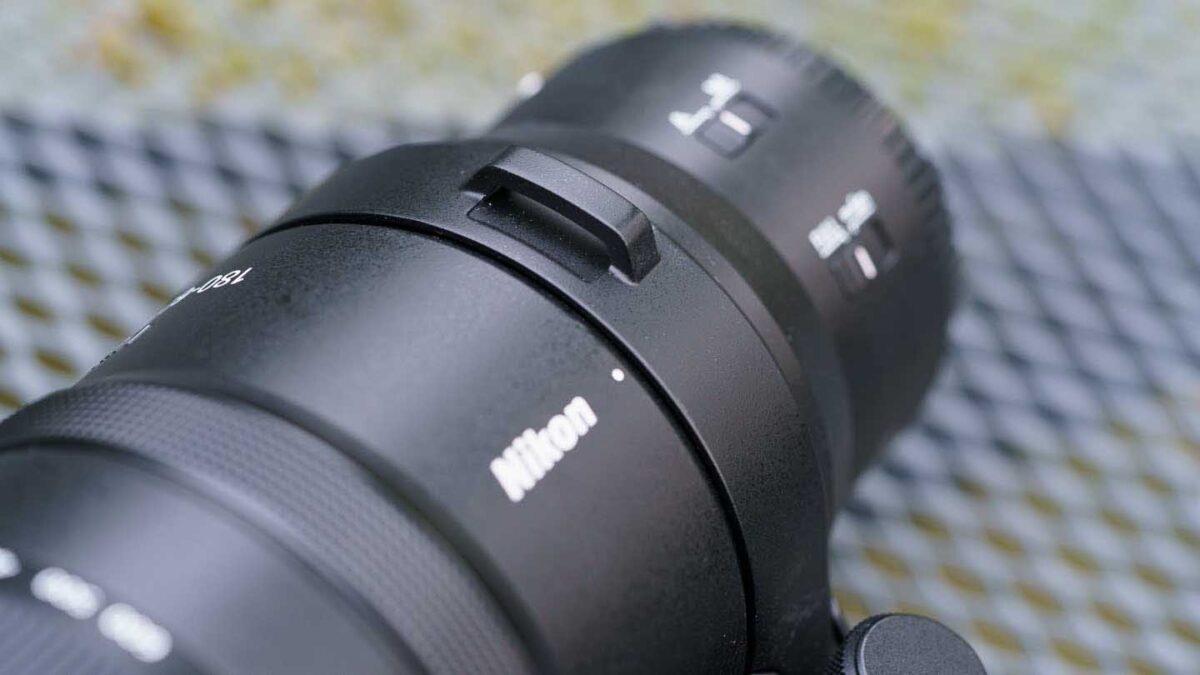
It’s essential to check that the collar is fixed correctly as it has strap lugs for carrying the camera and lens. If it’s not fixed properly, it can slip up the lens when it weight is taken by the strap lugs.
The lens strap lugs need to be used because the lens’s weight could damage the camera mount if the camera lugs are used.

There are two rings on the Z 180-600mm f/5.6-6.3 VR. As usual, the broad zoom ring sits around the halfway point along the barrel. This ring requires a quarter of a turn to zoom from 180mm to 600mm, which means you can react quickly to frame a moving subject. The ring moves smoothly and requires just the right amount of effort.
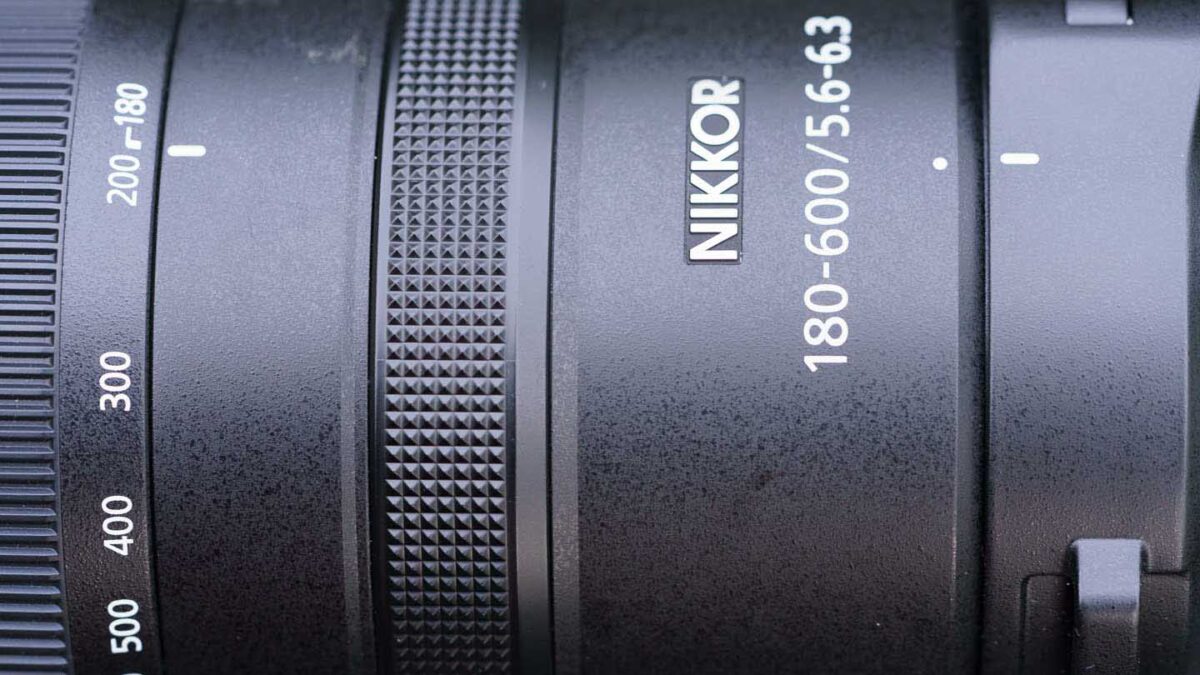
There’s also a customisable and clickless control ring, which sits further towards the camera between the zoom ring and the tripod collar. This ring has a knurled texture that gives a good grip. It can be used to focus manually or with the options selected via the menu, to adjust aperture, exposure compensation or ISO. Again, this moves smoothly, and as it operates electronically, the movement has no end points.
A switch near its mount lets you flick the lens between autofocus and manual focus mode.
Handily, the Z 180-600mm f/5.6-6.3 VR has a focus limiter switch. This has just two options: full or infinity to 6m. That’s useful if you’re photographing wildlife through foliage.
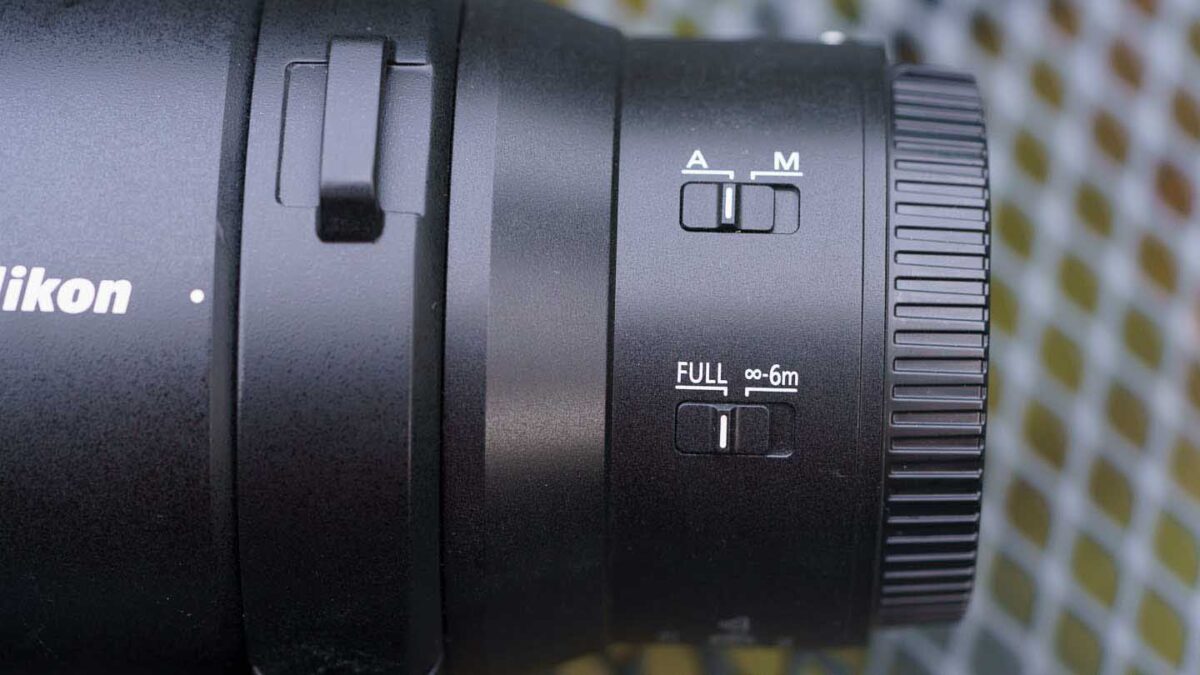
There are also four lens function buttons (L-Fn) arranged 90° apart just forward of the zoom ring. As the zoom ring is the natural place for supporting the lens with your left hand, these buttons are within convenient reach of your thumb whether you’re shooting in landscape or portrait orientation. These can be assigned one of a host of features via the camera menu.
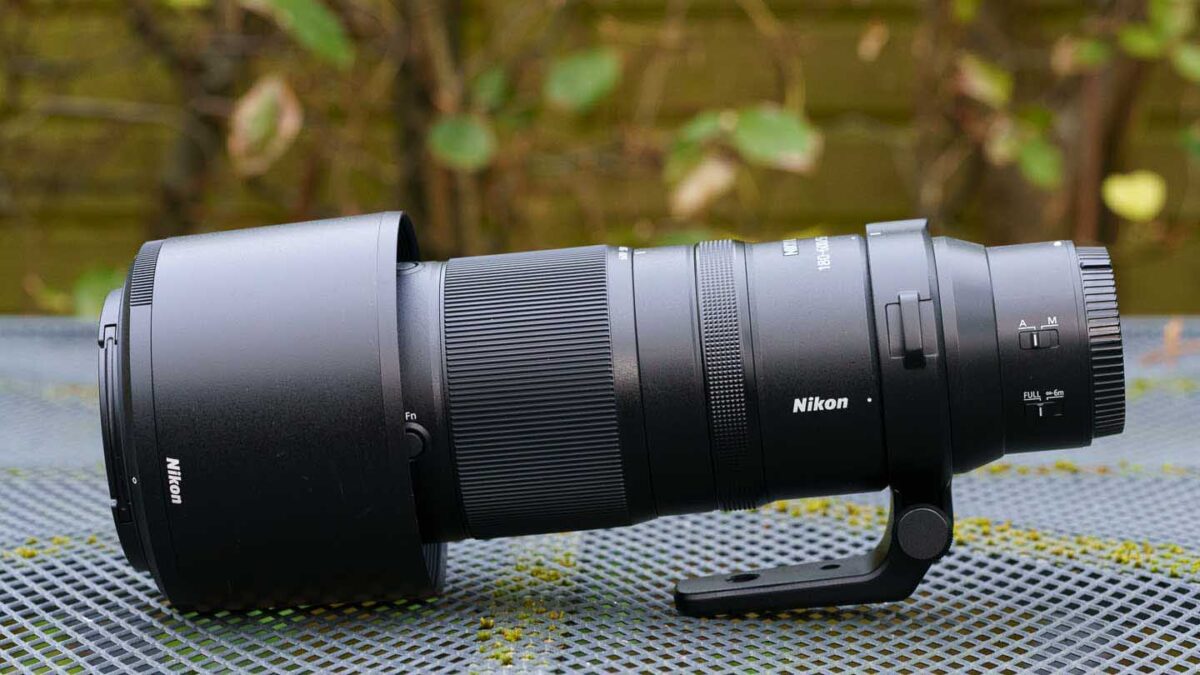
Performance
I used the Nikon Nikkor Z 180-600mm f/5.6-6.3 VR on the Nikon Z8 and Nikon Z7 II. It performed brilliantly on both cameras, but the advanced subject detection system of the Z8 proved its worth when I was photographing animals as it was quick to spot them and target an eye when one was visible. The focusing system also coped admirably in gloomy, overcast conditions and bright sunshine.
My images from the Nikon Z 180-600mm f/5.6-6.3 VR are impressively sharp across the frame and throughout the focal length range. There’s plenty of detail visible in the feathers and fur of the animals I photographed, and apart from some haze or mist from the weather conditions in some instances, shots of distant landscapes look good.
Chromatic aberration is kept under control and the automatic correction profiles tackle the mild vignetting and pincushion distortion very effectively.
On the Nikon Z8, and at the 600mm end of the Nikon Nikkor Z 180-600mm f/5.6-6.3 VR, I could get around 20% of my images perfectly sharp when using a shutter speed of 1/15 sec. That’s close to the 5.5EV claimed shutter speed compensation, but I needed to use 1/60sec to boost my hit rate to around 70%.
There are usually two concerns when using a lens with a relatively narrow maximum aperture: the first is that the sensitivity (ISO) level will have to rise to enable a fast enough shutter speed, and the second is that it’s not possible to separate a subject from its surroundings by selective focusing. The first point is more of an issue on an overcast winter’s day, but it’s worth considering how much noise control has improved in recent years. For instance, my raw files shot on the 45.7MP Nikon Z7 II at ISO 3200 look very good.
Also, at 600mm with a subject 6m from the sensor, the depth of field at f/6.3 (the largest aperture at that focal length) is just 3cm. If it were possible to open to f/4, the depth of field would drop to just 2cm, but that would demand a much bigger, heavier and more expensive optic. The fall-off in sharpness isn’t as rapid as it would be at f/4, but it’s still possible to make the subject stand out nicely from its background.
Nikon Nikkor Z 180-600mm f/5.6-6.3 VR Sample Images
Follow the link to browse and download full-resolution images shot using the Nikon Nikkor Z 180-600mm f5.6-6.3 VR. Please respect our copyright.
Verdict
The Nikon Nikkor Z 180-600mm f/5.6-6.3 VR is a highly versatile super-telephoto zoom lens, ideal for enthusiast photographers into sports, wildlife and aviation photography. Its compatibility with Nikon’s Z-series teleconverters extends its focal range significantly, making it a valuable option for capturing distant subjects.
Despite its substantial size and weight, the lens is manageable for handheld shooting, and its robust build and weather-sealing make it suitable for extensive outdoor use. With a sophisticated optical design that includes 6 ED and 1 aspherical elements, the Z 180-600mm f/5.6-6.3 VR delivers sharp, high-quality images throughout the zoom range, and Nikon’s VR technology allows sharp images at slower shutter speeds (provided the subject isn’t moving).
The lens’s performance is impressive, with excellent sharpness and well-controlled aberrations. The narrow maximum aperture may require higher ISO settings in low light, but Nikon’s Z-series cameras handle noise well. While the maximum aperture limits subject separation to some extent, the lens achieves effective background blur at longer focal lengths.
Overall, the Nikon Nikkor Z 180-600mm f/5.6-6.3 VR is a well-rounded lens, balancing zoom range, image quality, usability and affordability. It’s a notable addition to Nikon’s mirrorless lens lineup, however, care is required when adjusting the tripod collar.
